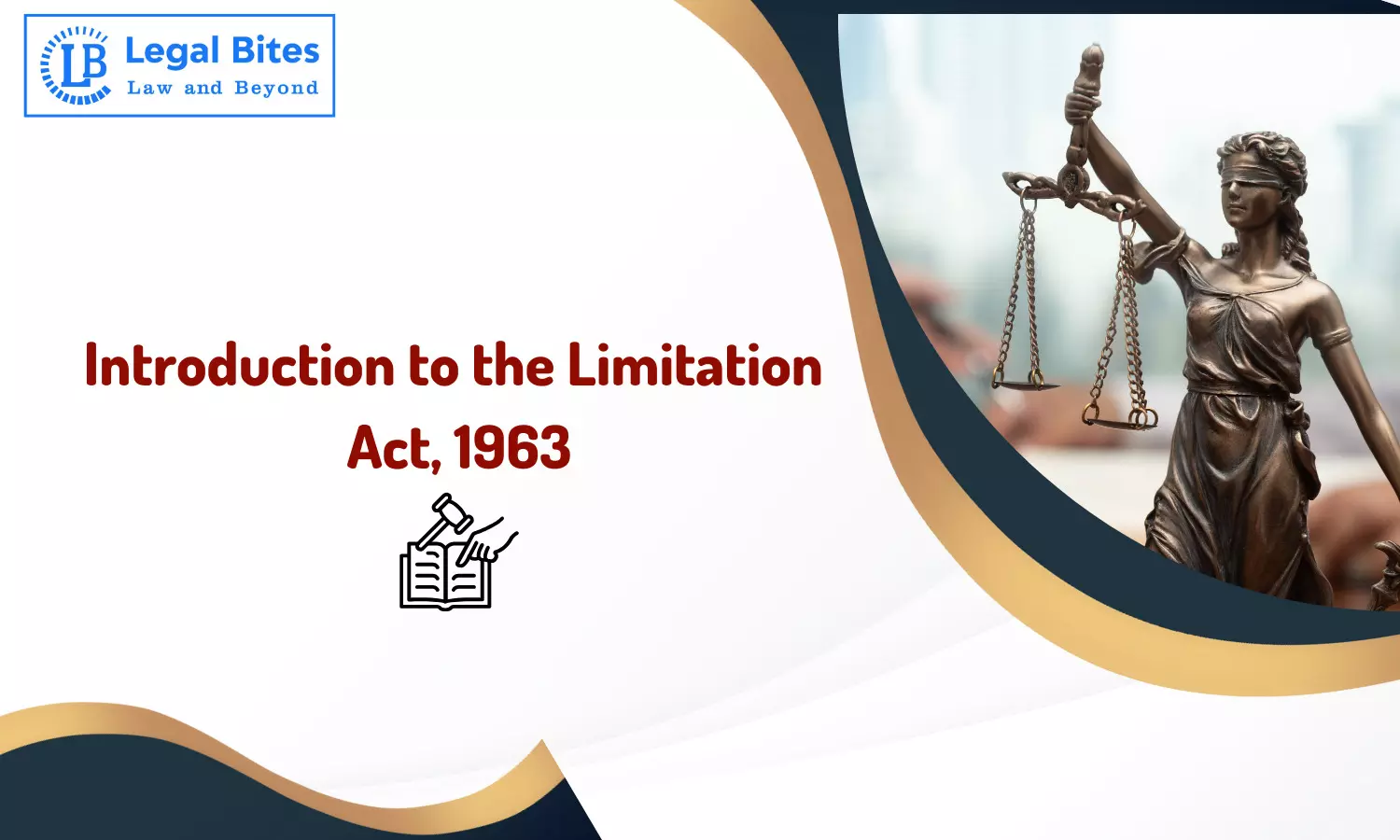Introduction to the Limitation Act, 1963
Here's an overview of the Limitation Act of 1963, shedding light on its historical evolution, objectives, and key provisions.

Here's an overview of the Limitation Act of 1963, shedding light on its historical evolution, objectives, and key provisions aimed at promoting fairness and expeditious resolution of legal disputes in India.
The Act in Brief
The Limitation Act of 1963, enacted by the Indian Parliament, establishes specific time limits within which certain legal actions or proceedings must be initiated or take place. No one can have unlimited time to initiate a suit, so for the efficient functioning of the Indian legal system, such limits are set. The Limitation Act (hereinafter as “the Act”) sets to establish the maximum duration within which a legal suit or claim can be filed. This is done to make sure that the disputes are resolved on time and it also mitigates the filing of stale cases. The long title of the Act states:
“the Act is to consolidate and amend the law for the limitation of suits and other proceedings and purposes connected therewith.”
This Act has been enacted to combine and amend all the laws relating to the limitation of suits and other legal proceedings and put it all in one single Act in an organised manner. This way all laws relating to limitation can be found in one single place. It aims to maintain a balance between the interest of the individuals who are filing a suit and the need for the finality of the corresponding legal proceedings. This promotes efficacy in the Indian legal system and allows for the timely resolution of disputes.
Object
The main objective of the Act is to specify a time limit within which legal actions or suits are to be commenced. Limiting any legal action gives effect to the maxim called interest reipublicae ut sit finis litium, which essentially means that there should be an end to litigation in the interest of the State. It has been held by the Supreme Court in N. Balakrishnan v. M. Krishnamurthy, (1998) 7 SCC 123, that the Act is based upon public policy and it is used to fix a life span of a legal remedy for the general welfare.
The time limit indeed aims to discourage unnecessary delay in initiating legal actions. In Smti Dehlia D. Sangma v. State of Meghalaya & Ors., WP(C) No. 74 of 2017, the Meghalaya High Court observed that there was a delay of 27 years in the initiation of legal action and that the petitioner had not been vigilant and “slept over his rights” as there was no reasonable explanation for the undue delay. The same is enshrined by a maxim called Vigilantibus Non Dormientibus Jura Subveniunt. Therefore, any individual seeking to assert their legal rights must know that these rights do not remain forever and one must be vigilant enough in affirming them on time. This way, the Act also promotes the concept of legal certainty and finality.
As aforementioned, the Act resorts to attaining a balance between the interests of the aggrieved party, who should have a reasonable time to initiate a legal proceeding, and the need for the legal system to prevent dormant suits to ensure efficacious resolution of the disputes. By providing specific time limits for various kinds of legal actions, the Act aims to facilitate a fair and just legal procedure for the resolution of any suit. At the same time, it also prevents the undue extension of litigation.
History
The Law of Limitation in India was first formulated in the year 1859, during British colonial rule. Before this, no uniform law for limitation existed in India. There were two distinct systems governing the law of limitation in India. In areas falling under the original jurisdiction of courts established by the Royal Charter in the Presidency towns of Calcutta, Madras, and Bombay, English law was applied. Conversely, in the mofussil courts, the law as prescribed by the Regulations was administered.
The Act No. XIV of 1859 was replaced by Act No. IX of 1871 which was called the “Indian Limitation Act, 1871.” This Act provided for the acquisition of easement and the termination of rights on land as well. This Act was then replaced by Act No. XV of 1877 which was said to be more comprehensive and extensive in nature and scope. This Act extended to include other movable properties. The 1877 Act was replaced by Act No. IX of 1908 which reiterated the provisions of the 1877 Act.
Now, this Act remained in force till the present Act No. XXXVI of 1963 was passed by the Parliament of independent India on the recommendation of the Law Commission of India in its Third Report as it felt the need to reform the Law of Limitation. This Act sought to bring some uniformity in the Law of Limitation in India. Ever since its enactment, the Act has gone through numerous amendments and changes as per the needs of the society and has accommodated the interests of the public as well as the State.
It is evident from the Law Commission report that the drafting of a reformed Law of Limitation was required to respond to the various restrictions of the previous legislation, so a thorough examination of the legal needs of the society as well as the State was done. In essence, this Act reflects a development of the Law of Limitation from a colonial-era legislation to a law of the independent India which is more comprehensive and unified. The drafting process addressed all the shortcomings of the previous legislation and tried to fill in the existing gaps while providing a balanced framework for the timely resolution of disputes.
The Limitation Act of 1963 was granted presidential assent on October 5th, 1963, and was subsequently published in the Gazette of India on that very date. It came into force on 1st January, 1964.
Code at a Glance
The Limitation Act of 1963 has currently 30 Sections and 137 Articles. The Sections have been divided into 5 parts as follows:
Parts | Titles | Sections |
I | Preliminary | Sections 1 & 2 |
II | Limitation of Suits, Appeals and Applications | Sections 3 to 11 |
III | Computation of Period of Limitation | Sections 12 to 24 |
IV | Acquisition of Ownership of Possession | Sections 25 to 27 |
V | Miscellaneous | Sections 28 to 32 |
It is to be noted that Sections 28 and 32 have been repealed by the Repealing and Amending Act, 1974 (56 of 1974), Section 2 and the First Schedule (w.e.f. 20-12-1974), therefore making the total number of Sections 30, and not 32.
Now, the Schedule of the Act specifies the limitation period for various kinds of suits. The Articles presented here are divided into 3 divisions which are further divided into various parts as follows:
First Division – Suits
Parts | Titles | Articles |
I | Suits Relating to Accounts | Articles 1 to 5 |
II | Suits Relating to Contracts | Articles 6 to 55 |
III | Suits Relating to Declarations | Articles 56 to 58 |
IV | Suits Relating to Decrees and Instruments | Articles 59 & 60 |
V | Suits Relating to Immovable Property | Articles 61 to 67 |
VI | Suits Relating to Movable Property | Articles 68 to 71 |
VII | Suits Relating to Tort | Articles 72 to 91 |
VIII | Suits Relating to Trusts and Trust Property | Articles 92 to 96 |
IX | Suits Relating to Miscellaneous Matters | Articles 97 to 112 |
X | Suits for Which There is no Prescribed Period | Article 113 |
Second Division – Appeals – Articles 114 to 117 (This division has no sub-divisions)
Third Division – Applications
Parts | Titles | Articles |
I | Applications in Specified Cases | Articles 118 to 136 |
II | Other Application | Article 137 |
Conclusion
The Limitation Act of 1963 was formulated to put an end to the colonial-era legislations relating to the Law of Limitation while also addressing the gaps that existed previously. The Act has also accommodated the needs and interests of the society as well as the State and has adapted to the constant change in the society through various amendments. The main purpose of the Act is to prevent any undue delay in the initiation of a legal action as well as to make sure that there is timely settlement of a dispute.
Click Here to Download the Limitation Act, 1963

